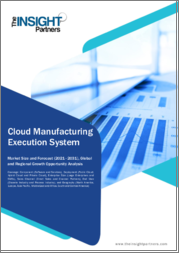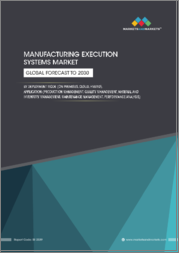
|
시장보고서
상품코드
1518447
제조 실행 시스템 시장 : 제공별, 전개 형태별, 프로세스 산업별, 개별 산업별, 지역별 - 세계 예측(-2030년)Manufacturing Execution Systems Market by Offering (Software, Services), Deployment Mode, Process Industry, Discrete Industry and Geography-Global Forecast to 2030 |
||||||
이 보고서는 '제조 실행 시스템 시장 : 제공, 전개 형태, 프로세스 산업, 개별 산업, 지역별 - 2031년까지 세계 예측'이라는 제목으로 주요 5개 지역의 제조 실행 시스템 시장을 상세히 분석했으며, 최근 시장 동향, 시장 규모, 시장 점유율, 최근 동향, 2031년까지의 예측 등의 정보를 정리하여 전해드립니다.
제조 실행 시스템 시장은 2024-2031년 CAGR 7.7%로 2031년까지 192억 달러에 달할 것으로 예상됩니다. 이 시장의 성장 배경에는 제조 작업의 복잡성 증가, 공정 및 개별 산업에서 산업 자동화 도입 증가, 규제 준수에 대한 중요성 증가 등이 있습니다. 그러나 막대한 자본 투자와 업그레이드 및 유지보수 비용의 필요성이 시장의 성장을 저해하는 요인으로 작용하고 있습니다.
또한, MES와 ERP 및 PLM과 같은 솔루션과의 통합과 제약 산업에서의 MES 사용 증가는 이 시장에서 사업을 운영하는 기업들에게 큰 비즈니스 기회가 될 것으로 예상됩니다. 그러나 다양한 산업에서 MES를 도입할 때 발생하는 복잡성은 이 시장의 성장에 도전이 되고 있습니다.
목차
제1장 소개
제2장 조사 방법
- 조사 가정
제3장 주요 요약
제4장 세계의 제조 실행 시스템 시장에 대한 COVID-19의 영향
제5장 시장 인사이트
- 소개
- 시장 역학
- 성장 촉진요인
- 제조 오퍼레이션 복잡화
- 프로세스와 디스크리트 산업의 산업용 자동화 채용 증가
- 규제 준수의 중요성 상승
- 성장 억제요인
- 거액의 설비 투자와 업그레이드·보수 비용의 필요성
- 기회
- ERP나 PLM 등의 솔루션과 MES의 통합
- 제약 업계의 MES 용도 증가
- 과제
- 다양한 산업의 MES 도입의 복잡성
- 밸류체인 분석
제6장 제조 실행 시스템 세계 시장 : 제공별
- 소개
- 소프트웨어
- 서비스
- 임플리멘테이션
- 소프트웨어 업그레이드
- 트레이닝
- 기타
제7장 제조 실행 시스템 세계 시장 : 전개 형태별
- 소개
- 온프레미스 전개
- 온디맨드 전개
- 하이브리드 전개
제8장 제조 실행 시스템 세계 시장 : 용도별
- 소개
- 모니터링
- 생산 관리
- 생산 문서화
- 생산 폐기
- 재고 관리
- 유지보수
- 품질 관리
- 공장 전체의 생산 계획
- 기타
제9장 제조 실행 시스템 세계 시장 : 최종 이용 산업별
- 소개
- 프로세스 산업
- 식품 및 음료 산업
- 석유 및 가스
- 화학
- 제지·펄프
- 제약·생명과학
- 에너지·전력
- 상하수도
- 기타 프로세스 산업
- 개별 산업
- 소개
- 자동차 산업
- 항공우주
- 소비재
- 의료기기
- 기타 디스크리트 산업
제10장 제조 실행 시스템 시장 : 지역별
- 소개
- 아시아태평양
- 중국
- 일본
- 한국
- 인도
- 호주
- 싱가포르
- 기타 아시아태평양
- 유럽
- 독일
- 영국
- 프랑스
- 이탈리아
- 스페인
- 스위스
- 기타 유럽
- 북미
- 미국
- 캐나다
- 라틴아메리카
- 중동 및 아프리카
제11장 경쟁 상황
- 소개
- 주요 성장 전략
- 경쟁 벤치마킹
- 세계의 제조 실행 시스템 시장의 주요 기업
제12장 기업 개요(사업 개요, 재무 개요, 제품 포트폴리오, 전략적 전개)
- Siemens AG
- Rockwell Automation, Inc.
- SAP SE
- ABB Ltd
- Dassault Systemes S.A.
- AVEVA Group Plc
- Applied Materials Inc.
- Oracle Corporation
- General Electric Company
- Emerson Electric Co.
- Epicor Software Corporation
- Infor Equity Holdings LLC
- Eyelit Inc.
- Aegis Industrial Software Corporation.
- Critical Manufacturing SA
제13장 부록
ksm 24.07.31Manufacturing Execution Systems Market by Offering (Software, Services), Deployment Mode, Process Industry, Discrete Industry and Geography-Global Forecast to 2031.
The research report titled, 'Manufacturing Execution Systems Market by Offering (Software, Services), Deployment Mode, Process Industry, Discrete Industry, and Geography-Global Forecast to 2031', provides an in-depth analysis of the manufacturing execution systems market across five major geographies and emphasizes on the current market trends, market sizes, market shares, recent developments, and forecasts till 2031.
The manufacturing execution systems market is projected to reach $19.2 billion by 2031, at a CAGR of 7.7% from 2024 to 2031. This market's growth is attributed to the growing complexity of manufacturing operations, the rising adoption of industrial automation in process & discrete industries, and the increasing significance of regulatory compliances. However, the requirement for significant capital investments and upgradation & maintenance costs are restraining the growth of this market.
Furthermore, the integration of MES with solutions such as ERP and PLM and increasing applications of MES in the pharmaceutical industry are expected to create significant opportunities for the players operating in this market. However, the complexities in deploying MES in various industries pose challenges to the growth of this market.
The global manufacturing execution systems market is segmented by offering (software and services), deployment mode (on-premise, on-demand, and hybrid deployment), application (monitoring, production control, production documentation, production disposition, inventory management, maintenance, quality management, plant-wide production planning, and other applications), and end-use industry (process industry and discrete industry). This study also evaluates industry competitors and analyzes the regional and country-level markets.
Based on offering, the global manufacturing execution systems market is segmented into software and services. The growth of the services segment is attributed to the increasing significance of the post-implementation procedure of several industrial execution systems. Moreover, the services segment is also estimated to register the highest CAGR during the forecast period. Factors expected to drive growth and demand for the services segment during the forecast period include increased efficiency, reduced waste, and shorter output times in the manufacturing process of various applications in industries such as food & beverages, pharmaceuticals, and consumer packaged goods, among others.
Based on deployment mode, the global manufacturing execution systems market is segmented into on-premise deployment, on-demand deployment, and hybrid deployment. In 2024, the on-premise deployment segment is expected to account for the largest share of the global manufacturing execution systems market. This segment's large market share is attributed to manufacturers' increasing adoption of MES to retain all their existing processes and internal systems, such as authentication & access credentials.
Based on application, the global manufacturing execution systems market is segmented into monitoring, production control, production documentation, production disposition, inventory management, maintenance, quality management, plant-wide production planning, and other applications. In 2024, the monitoring segment is expected to account for the largest share of the global manufacturing execution systems market. This segment's large market share is attributed to the growing need to analyze real-time data to provide improved performance contextually and automated workflows, product transactions, and manual tasks to ensure top accuracy.
Based on end-use industry, the global manufacturing execution systems market is segmented into process industry and discrete industry. In 2024, the discrete industry segment is expected to account for the largest share of the global manufacturing execution systems market. In discrete industries such as automotive manufacturing plants, consumer packaged goods, and medical devices, manufacturing execution systems are used to deliver information that enables the optimization of production activities from order launch to finished goods. The use of manufacturing execution systems in discrete industries assists in efficiently monitoring the performance of the manufacturing processes comprising the production of a variety of modules and parts, devices, and other goods.
Based on geography, the global manufacturing execution systems market is segmented into North America, Europe, Asia-Pacific, Latin America, and the Middle East & Africa. In 2024, North America is expected to account for the largest share of the global manufacturing execution systems market. This region's large market share is attributed to the presence of several MES key players, such as Rockwell Automation, Inc. (U.S.), AVEVA Group Plc (U.K.), Applied Materials Inc. (U.S.), Oracle Corporation (U.S.), General Electric Company (U.S.), Emerson Electric Co. (U.S.), Epicor Software Corporation (U.S.), and Infor Equity Holdings LLC (U.S.).
Moreover, North America's strong financial position enables it to invest heavily in advanced solutions & technologies that have provided a competitive edge in the market.
Key Players:
The key players operating in the manufacturing execution systems market are Siemens AG (Germany), Rockwell Automation, Inc. (U.S.), SAP SE (Germany), ABB Ltd (Switzerland), Dassault Systemes S.A. (France), AVEVA Group Plc (U.K.), Applied Materials Inc. (U.S.), Oracle Corporation (U.S.), General Electric Company (U.S.), Emerson Electric Co. (U.S.), Epicor Software Corporation (U.S.), Infor Equity Holdings LLC (U.S.), Eyelit Inc. (Canada), Aegis Industrial Software Corporation (U.S.) and Critical Manufacturing, S.A. (Portugal).
Key questions answered in the report-
- Which are the high-growth market segments based on offering, deployment mode, process industry, discrete industry, and geography?
- What is the historical market size for manufacturing execution systems across the globe?
- What are the market forecasts and estimates for the period 2024-2031?
- What are the major drivers, restraints, opportunities, and challenges in the global manufacturing execution systems market?
- Who are the major players in the market, and what are their market shares?
- How is the competitive landscape for the global manufacturing execution systems market?
- What are the recent developments in the global manufacturing execution systems market?
- What do the major players in the market adopt the different strategies?
- What are the key geographic trends, and which are the high-growth countries?
- Who are the local emerging players in the global manufacturing execution systems market, and how do they compete with other players?
Scope of the report:
Manufacturing Execution Systems Market-by Offering
- Software
- Services
- Implementation
- Software Upgradation
- Training
- Other Services
Manufacturing Execution Systems Market-by Deployment Mode
- On-premise Deployment
- On-demand Deployment
- Hybrid Deployment
Manufacturing Execution Systems Market-by Application
- Monitoring
- Production Control
- Production Documentation
- Production Disposition
- Inventory Management
- Maintenance
- Quality Management
- Plant-wide Production Planning
- Other Applications
Manufacturing Execution Systems Market-by End-use Industry
- Process Industry
- Food & Beverages
- Oil & Gas
- Chemicals
- Paper & Pulp
- Pharmaceuticals & Life Sciences
- Energy & Power
- Water & Wastewater
- Other Process Industries
- Discrete Industry
- Introduction
- Automotive
- Aerospace
- Consumer Packaged Goods
- Medical Devices
- Other Discrete Industries
Manufacturing Execution Systems Market-by Geography
- Asia-Pacific
- China
- Japan
- South Korea
- India
- Australia
- Singapore
- Rest of Asia-Pacific
- Europe
- Germany
- U.K.
- France
- Italy
- Spain
- Switzerland
- Rest of Europe
- North America
- U.S.
- Canada
- Latin America
- Middle East & Africa
TABLE OF CONTENTS
1. Introduction
- 1.1. Market Definition
- 1.2. Market Ecosystem
- 1.3. Currency and Limitations
- 1.4. Key Stakeholders
2. Research Methodology
- 2.1. Research Process
- 2.2. Data Collection & Validation
- 2.2.1. Secondary Research
- 2.2.2. Primary Research
- 2.3. Market Assessment
- 2.3.1. Market Size Estimation
- 2.3.1.1. Bottom-up Approach
- 2.3.1.2. Top-down Approach
- 2.3.1.3. Growth Forecast
- 2.3.1. Market Size Estimation
- 2.4. Assumptions for the Study
3. Executive Summary
4. The Impact of COVID-19 on the Global Manufacturing Execution Systems Market
5. Market Insights
- 5.1. Introduction
- 5.2. Market Dynamics
- 5.3. Drivers
- 5.3.1. Growing Complexity of Manufacturing Operations
- 5.3.2. Rising Adoption of Industrial Automation in Process and Discrete Industries
- 5.3.3. Increasing Significance of Regulatory Compliances
- 5.4. Restraints
- 5.4.1. Requirement for Significant Capital Investments and Upgradation & Maintenance Costs
- 5.5. Opportunities
- 5.5.1. Integration of MES with Solutions Such as ERP and PLM
- 5.5.2. Increasing Applications of MES in the Pharmaceutical Industry
- 5.6. Challenges
- 5.6.1. Complexities in Deploying MES in Various Industries
- 5.7. Value Chain Analysis
6. Global Manufacturing Execution Systems Market, by Offering
- 6.1. Introduction
- 6.2. Software
- 6.3. Services
- 6.3.1. Implementation
- 6.3.2. Software Upgradation
- 6.3.3. Training
- 6.3.4. Other Services
7. Global Manufacturing Execution Systems Market, by Deployment Mode
- 7.1. Introduction
- 7.2. On-premise Deployment
- 7.3. On-demand Deployment
- 7.4. Hybrid Deployment
8. Global Manufacturing Execution Systems Market, by Application
- 8.1. Introduction
- 8.2. Monitoring
- 8.3. Production Control
- 8.4. Production Documentation
- 8.5. Production Disposition
- 8.6. Inventory Management
- 8.7. Maintenance
- 8.8. Quality Management
- 8.9. Plant-wide Production Planning
- 8.10. Other Applications
9. Global Manufacturing Execution Systems Market, by End-use Industry
- 9.1. Introduction
- 9.2. Process Industry
- 9.2.1. Food & Beverages
- 9.2.2. Oil & Gas
- 9.2.3. Chemicals
- 9.2.4. Paper & Pulp
- 9.2.5. Pharmaceuticals & Life Sciences
- 9.2.6. Energy & Power
- 9.2.7. Water & Wastewater
- 9.2.8. Other Process Industries
- 9.3. Discrete Industry
- 9.3.1. Introduction
- 9.3.2. Automotive
- 9.3.3. Aerospace
- 9.3.4. Consumer Packaged Goods
- 9.3.5. Medical Devices
- 9.3.6. Other Discrete Industries
10. Manufacturing Execution Systems Market, by Geography
- 10.1. Introduction
- 10.2. Asia-Pacific
- 10.2.1. China
- 10.2.2. Japan
- 10.2.3. South Korea
- 10.2.4. India
- 10.2.5. Australia
- 10.2.6. Singapore
- 10.2.7. Rest of Asia-Pacific
- 10.3. Europe
- 10.3.1. Germany
- 10.3.2. U.K.
- 10.3.3. France
- 10.3.4. Italy
- 10.3.5. Spain
- 10.3.6. Switzerland
- 10.3.7. Rest of Europe (RoE)
- 10.4. North America
- 10.4.1. U.S.
- 10.4.2. Canada
- 10.5. Latin America
- 10.6. Middle East & Africa (MEA)
11. Competitive Landscape
- 11.1. Introduction
- 11.2. Key Growth Strategies
- 11.3. Competitive Benchmarking
- 11.4. Key Players in the Global Manufacturing Execution Systems Market
12. Company Profiles (Business Overview, Financial Overview, Product Portfolio, and Strategic Developments)
- 12.1. Siemens AG
- 12.2. Rockwell Automation, Inc.
- 12.3. SAP SE
- 12.4. ABB Ltd
- 12.5. Dassault Systemes S.A.
- 12.6. AVEVA Group Plc
- 12.7. Applied Materials Inc.
- 12.8. Oracle Corporation
- 12.9. General Electric Company
- 12.10. Emerson Electric Co.
- 12.11. Epicor Software Corporation
- 12.12. Infor Equity Holdings LLC
- 12.13. Eyelit Inc.
- 12.14. Aegis Industrial Software Corporation.
- 12.15. Critical Manufacturing SA
13. Appendix
- 13.1. Questionnaire
- 13.2. Available Customization



















